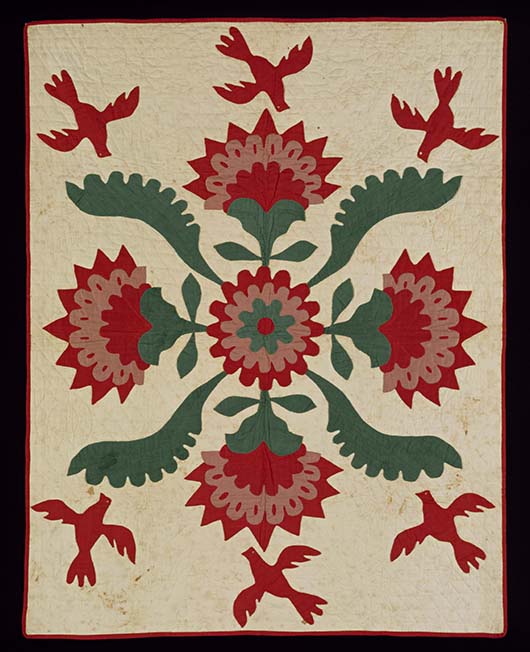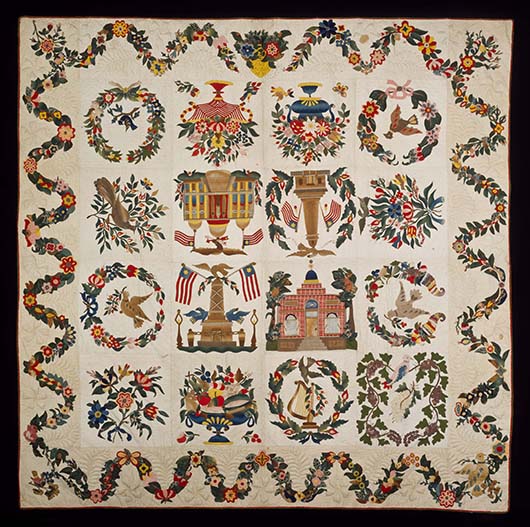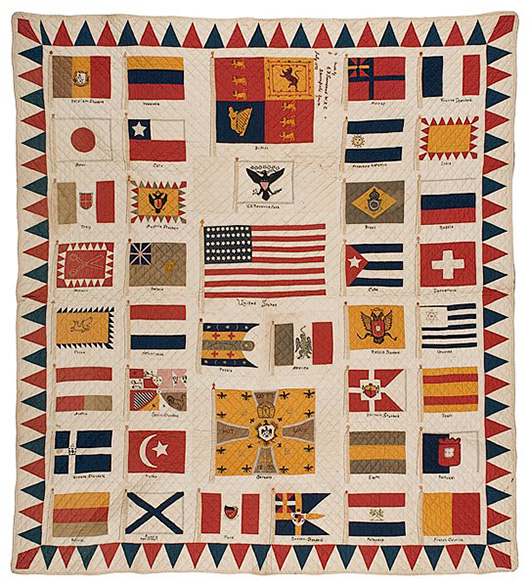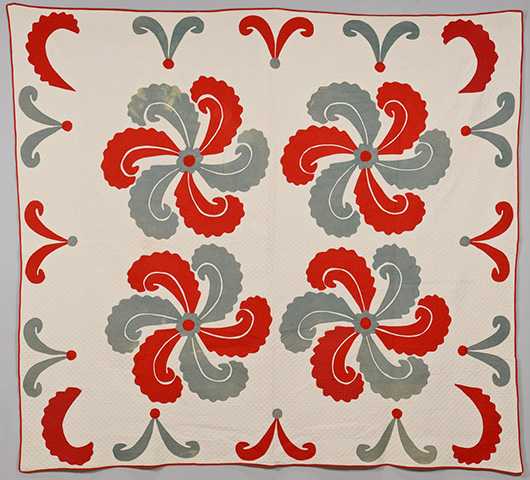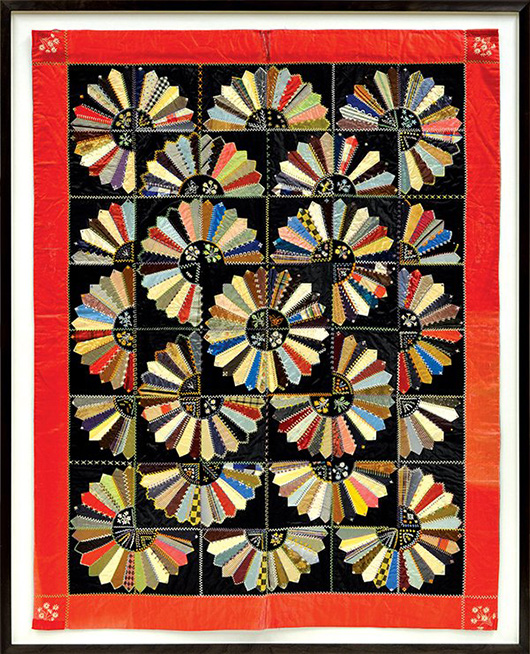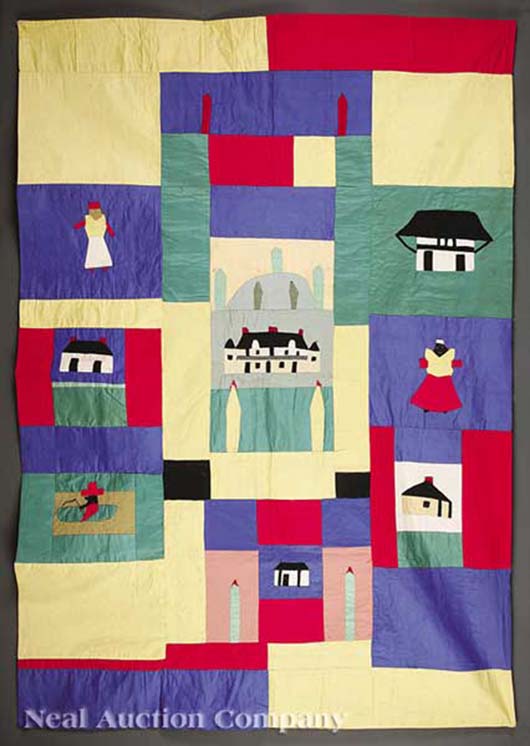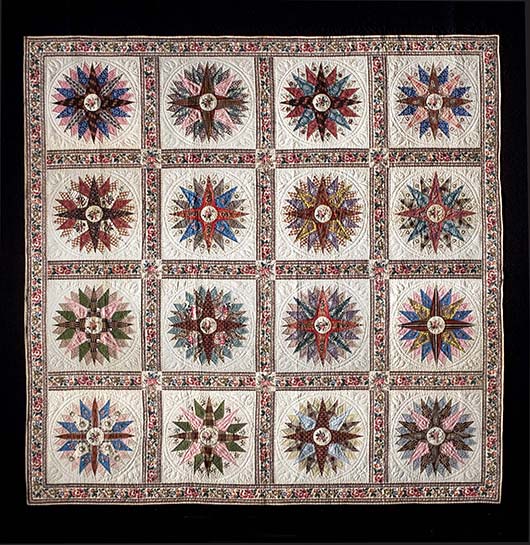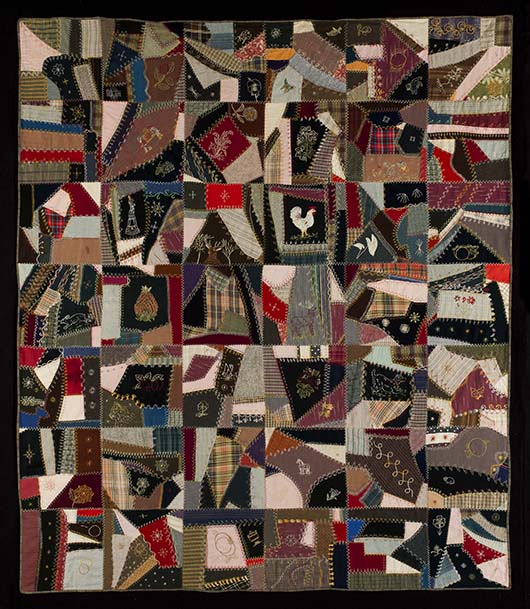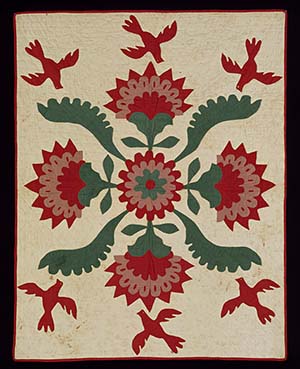
Accompanying the publication, a new exhibition – “A Celebration of American Quilts” – will be on view at the DeWitt Wallace Decorative Arts Museum through June 30, 2016. Curators have chosen 12 superb quilts from the permanent collection, drawing examples from across the country – Virginia to Hawaii, New Hampshire to Alabama. Quilts have a utilitarian function, but their decoration became an important outlet for the creativity of the women who designed and stitched them.
Quilts have a strong appeal to collectors because they offer a style for every taste and pocketbook. There are six-figure masterpieces at auction, which will be displayed on a wall as fine art, and colorful quilts sold for a few hundred dollars that can be put right in the master bedroom. Collections often begin with a family quilt in a simple star or wedding ring pattern that spurs the owner to seek out complementary examples. Interested buyers may specialize in quilts from a particular period, region of manufacture, pattern group, or even color scheme. A simple search for “quilts” will bring up examples for sale and recently sold for further study, an excellent way to become acquainted with current prices for antique textiles.
The Williamsburg catalog and exhibition represent years of research on the part of Linda Baumgarten, curator of Textiles and Costumes, and Kimberly Smith Ivey, curator of Textiles and Historic Interiors. In a conversation with Auction Central News, Baumgarten said, “Kim and I have worked together for many years, and we realized early on that we had such important quilts that they needed their own publication. So we worked toward that goal, and then our very generous donors, Mary and Clinton Gilliland through the Turner-Gilliland Family Fund of the Silicon Valley Community Foundation, made it possible.”
She continued, “The goal of the book was to introduce people to the breadth of the Williamsburg collection, hence the title Four Centuries of Quilts. We do have an amazing collection that people aren’t familiar with, and we grouped them by how we think people will be able to best grasp the different concepts. For example, putting the red and white ones together because turkey red – the colorfast red dye – was such an integral part of that fashion for red and white. And we grouped the early quilts from India together to show how they influenced a lot of quilts that came after.”
The curators’ goal was simple: “Readers will see the variety that quilts can have – the incredible variety of techniques and quilting and piecing styles. Part of the Colonial Williamsburg mission is to teach people, and a book like this will teach readers about the past and the women who made these quilts. We’re not necessarily collecting the best of the best – we’re collecting quilts with interesting stories and histories which also happen to be pretty wonderful objects.”
Even at around 350 pages, a single volume cannot chronicle all quilts in this significant collection, but the authors have selected outstanding examples to illustrate various categories. The book’s design and layout – done in house by Shanin Glenn – is visually stimulating and extraordinarily readable. Each chapter offers surprises: a reader who thinks they know everything about Baltimore Album quilts or Amish designs will find never-before-seen examples and new information. Most important are the opening chapters on the formative influences in American quilting, such as the intricate stitching patterns on Indian textiles, the all-white bedcoverings made in France, or the European use of calico fabric. One revelation is a section on the distinctive patterns found in Hawaiian and Polynesian quilts, which includes a vintage photo of two master needleworkers at work in Honolulu. Documentation and dating of the quilts is discussed throughout, and a chapter titled “Meet the Makers” puts faces and biographies with individual creations.
Baumgarten explained how difficult it was to choose 12 quilts for exhibition from the broader collection: “The exhibit is in the American Folk Art Gallery, so we chose first American, then folk art quilts, and then a range of dates and types. There’s a show quilt made with fans and embroidery, a Virginia 1840s example, an African-American quilt from Alabama made by Susana Allen Hunter, a New Hampshire wholecloth wool example, an Amish quilt in a fans design, and an album type with family signatures.”
What kind of quilts appeal most to the curator? “My favorite quilt is usually one I’m working on at the time. Right now, I’m working on Amish quilts and the stitching designs in the Amish quilts. I’m looking through examples to try to trace how often they repeated those same feather quilting designs. That’s new research that I’m just starting, but I’m also keenly interested in the printed quilts because we’re getting ready to put up an exhibit in two years of printed textiles from our collection which will include a few quilts. In fact, one of those beautiful palampores we show in the book will be included in that exhibition.”
The holiday season is a wonderful time to see Colonial Williamsburg decked out for Yuletide festivities. “A World Made Small,” another exhibition focusing on antique miniatures and dollhouses, opens Dec. 5.
For information and events schedules, visit www.colonialwilliamsburg.com Four Centuries of Quilts ($75) can be ordered by calling 757- 220-7693 or go to www.williamsburgmarketplace.com and click on Bookstore, where you will also find the 2015 Williamsburg American Quilt Calendar ($18).
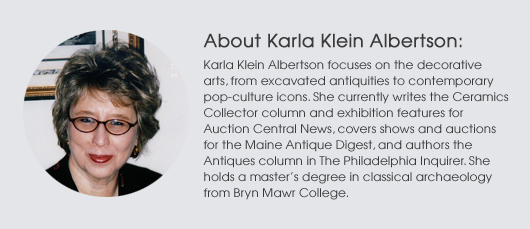
ADDITIONAL IMAGES OF NOTE
